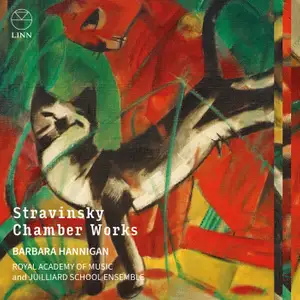
Igor Stravinsky (1882-1971)
Chamber Works
Alexandra Heath (soprano)
Royal Academy of Music & Julliard School Ensemble/Barbara Hannigan, Charlotte Corderoy (Concertino)
rec. 2023, Susie Sainsbury Theatre, Royal Academy of Music, London, UK
Linn CKD 722 [64]
The Royal Academy of Music and the Juilliard School, two world-class musical education institutions, have enjoyed a performing relationship based on over 20 years of regular exchanges, projects and recordings. There have been Proms appearances, a joint commission for Peter Maxwell Davies, and distinguished guest conductors including John Adams. Barbara Hannigan, now the Reinbert de Leeuw Professor of Music at the Academy, here conducts this very skilled transatlantic group in a programme of Stravinsky’s chamber ensemble works, mostly instrumental, and a few short vocal items.
The Concerto in E-flat major is subtitled “Dumbarton Oaks” after the grand home where it was premiered, a commission from the owners of the estate. It was conducted then, as here, by a woman, hardly noteworthy nowadays but less common in the 1930s. She was no ordinary musician, but Stravinsky’s distinguished friend and supporter, Nadia Boulanger. Stravinsky expressly requested she should be invited to direct the premiere when he himself was indisposed.
One suspects that the players in 1938 might not have been as comfortable with the neoclassical idiom as these young players seem to be. If anything, they are a bit too relaxed, adding time to each of the three movements compared to the composer’s own 1962 recording. So, 4:22 becomes 4:41, 4:14 becomes 4:21, and 5:05 becomes 5:25. This might seem marginal, but it is noticeable, especially in the spirited finale marked con moto. That forward motion is felt a touch more in the older account, a fleetness of foot that seems just right.
There is a similar tempo difference in the Septet, also first played at Dumbarton Oaks. Stravinsky’s 1965 timings are 3:20, 4:35 and 3:51, Hannigan’s 4:03, 5:17 and 3:33. That swiftness of the Gigue finale is to its advantage, but the central Passacaglia, while still eloquent, feels a bit becalmed in a few slower moments.
Stravinsky’s 1961 recording of the wonderful Octet and Hannigan’s reading sound very similar – and very satisfying. The six-minute Concertino is the twelve-instrument version the composer made of his 1920 string quartet. The able young conductor Charlotte Corderoy relishes its modernist asperities. The brief Ragtime benefits from the clear recording of the jangling cimbalom. In all these pieces, the students display the mastery of their instruments in this metrically tricky music.
The three sets of very short songs (none exceeds 1:39) are Stravinskian small beer. Alexandra Heath adopts a “small-voiced” approach with her accurate and pure-toned soprano that suits them well. There is a helpful booklet note on the music, and English translations of the absent original song texts.
Not everyone will want the 56 CDs and one DVD of Igor Stravinsky – The Complete Columbia Album Collection (Sony Music Classical 0888750261625), from which I took the timings. There is, however, no more important surviving set of documents for any great composer. I do not know of another recording with the exact programme on this Linn disc. If here and there one or two movements could do with a touch more Stravinskian edge, such absence does not spoil any of these satisfying accounts of this marvellous music.
Roy Westbrook
Buying this recording via a link below generates revenue for MWI and helps us keep free access to the site



Contents
Concerto in E-flat major “Dumbarton Oaks” (1938)
Three Japanese Lyrics (1913)
Two Poems of Balmont (1911)
Septet (1953)
Three Little Songs (“Recollections of my childhood”) (1913)
Octet (1923)
Concertino for Twelve Instruments (1952)
Ragtime for Eleven Instruments (1918)

















